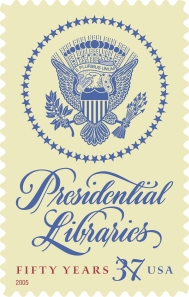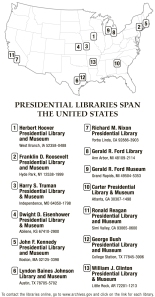The George W. Bush Presidential Library and Museum will be officially dedicated today in Dallas, Texas. We are marking the occasion with a look back at the Presidential Libraries stamp, which was issued in 2005 to commemorate the 50th anniversary of the Presidential Libraries Act of 1955.
 The Act, which enabled Presidents to donate their materials to the federal government for preservation and public access, was inspired by the example of President Franklin D. Roosevelt. Articulating the need for a safe, accessible archive for the materials of each administration, President Roosevelt stated that a repository was needed to “bring together the records of the past and to house them in buildings where they will be preserved for the use of men and women in the future.”
The Act, which enabled Presidents to donate their materials to the federal government for preservation and public access, was inspired by the example of President Franklin D. Roosevelt. Articulating the need for a safe, accessible archive for the materials of each administration, President Roosevelt stated that a repository was needed to “bring together the records of the past and to house them in buildings where they will be preserved for the use of men and women in the future.”
Since then, Presidential Libraries have been established in the home state of each President. Funds to build the libraries come from private sources, while the National Archives and Records Administration (NARA), under the auspices of the federal government, provides for their maintenance and operation.
The Presidential Records Act of 1978 went further and defined all papers generated during a President’s completed term in office as the property of the United States Government and placed the records under the custody of the Archivist of the United States. The 1978 act also established that the Presidential Library system should continue as the repository for subsequent Presidential records.
 The George W. Bush Presidential Library and Museum opens to the public on May 1, 2013. As citizens in a democracy, Americans have the right and are encouraged to visit the Presidential Libraries. At every library, casual visitors and serious scholars alike, will find, in addition to an accessible archive of Presidential papers, an associated museum that offers an ongoing series of public programs on a variety of cultural and historical topics. Many of the programs cater to school-age children.
The George W. Bush Presidential Library and Museum opens to the public on May 1, 2013. As citizens in a democracy, Americans have the right and are encouraged to visit the Presidential Libraries. At every library, casual visitors and serious scholars alike, will find, in addition to an accessible archive of Presidential papers, an associated museum that offers an ongoing series of public programs on a variety of cultural and historical topics. Many of the programs cater to school-age children.
At the time the Presidential Libraries stamp was issued, there were 11 libraries in the system housing materials from the administrations of Presidents Herbert Hoover, Franklin D. Roosevelt, Harry S. Truman, Dwight D. Eisenhower, John F. Kennedy, Lyndon Baines Johnson, Gerald R. Ford, Jimmy Carter, Ronald Reagan, George H. W. Bush, and William J. Clinton. (The Richard M. Nixon Presidential Library was added soon after the stamp’s release.)
The Presidential Libraries stamp was issued at one of these libraries. Which one was it?
Send your answer—along with your name and mailing address—to uspsstamps [at] gmail [dot] com. If you answer correctly you will automatically be entered to win a collectible Presidential Libraries ceremony program. We have 14 programs to give away, so there are plenty of chances to win. A 15th winner will receive not only the official 2005 ceremony program but also one Presidential Libraries American Commemorative Panel. This limited-edition, full-color collectible includes informative text about the stamps, photographs, and four mounted, mint-condition Presidential Libraries stamps.

All winners will be selected at random. The deadline for entries is 11:59 p.m. EDT Friday, April 26. Good luck!
Congratulations to the winners of the Presidential Libraries giveaway. We tried to fool you with a trick question, but you all are too smart for us. The stamps were issued at all of the libraries, so every answer was a correct answer! All 15 winners have already been notified by email. If you didn’t win this time, stick around because there’s bound to be another contest just around the corner.






